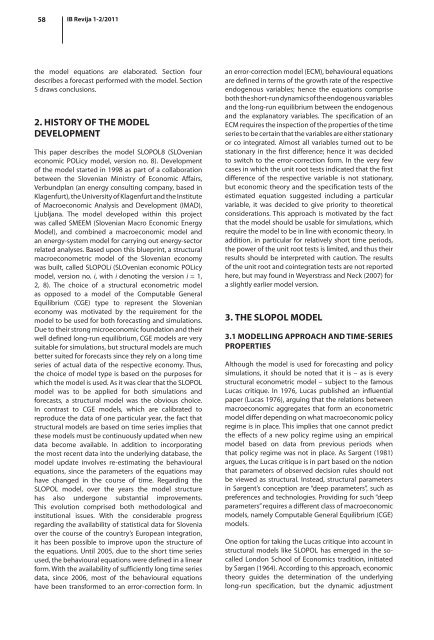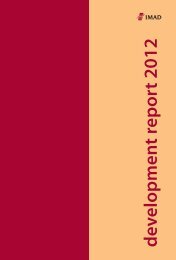Create successful ePaper yourself
Turn your PDF publications into a flip-book with our unique Google optimized e-Paper software.
58 IB Revija 1-2/<strong>2011</strong><br />
the model equations are elaborated. Section four<br />
describes a forecast performed with the model. Section<br />
5 draws conclusions.<br />
2. History of the model<br />
development<br />
This paper describes the model SLOPOL8 (SLOvenian<br />
economic POLicy model, version no. 8). Development<br />
of the model started in 1998 as part of a collaboration<br />
between the Slovenian Ministry of Economic Affairs,<br />
Verbundplan (an energy consulting company, based in<br />
Klagenfurt), the University of Klagenfurt and the Institute<br />
of Macroeconomic Analysis and Development (IMAD),<br />
Ljubljana. The model developed within this project<br />
was called SMEEM (Slovenian Macro Economic Energy<br />
Model), and combined a macroeconomic model and<br />
an energy-system model for carrying out energy-sector<br />
related analyses. Based upon this blueprint, a structural<br />
macroeconometric model of the Slovenian economy<br />
was built, called SLOPOLi (SLOvenian economic POLicy<br />
model, version no. i, with i denoting the version i = 1,<br />
2, 8). The choice of a structural econometric model<br />
as opposed to a model of the Computable General<br />
Equilibrium (CGE) type to represent the Slovenian<br />
economy was motivated by the requirement for the<br />
model to be used for both forecasting and simulations.<br />
Due to their strong microeconomic foundation and their<br />
well defined long-run equilibrium, CGE models are very<br />
suitable for simulations, but structural models are much<br />
better suited for forecasts since they rely on a long time<br />
series of actual data of the respective economy. Thus,<br />
the choice of model type is based on the purposes for<br />
which the model is used. As it was clear that the SLOPOL<br />
model was to be applied for both simulations and<br />
forecasts, a structural model was the obvious choice.<br />
In contrast to CGE models, which are calibrated to<br />
reproduce the data of one particular year, the fact that<br />
structural models are based on time series implies that<br />
these models must be continuously updated when new<br />
data become available. In addition to incorporating<br />
the most recent data into the underlying database, the<br />
model update involves re-estimating the behavioural<br />
equations, since the parameters of the equations may<br />
have changed in the course of time. Regarding the<br />
SLOPOL model, over the years the model structure<br />
has also undergone substantial improvements.<br />
This evolution comprised both methodological and<br />
institutional issues. With the considerable progress<br />
regarding the availability of statistical data for Slovenia<br />
over the course of the country’s European integration,<br />
it has been possible to improve upon the structure of<br />
the equations. Until 2005, due to the short time series<br />
used, the behavioural equations were defined in a linear<br />
form. With the availability of sufficiently long time series<br />
data, since 2006, most of the behavioural equations<br />
have been transformed to an error-correction form. In<br />
an error-correction model (ECM), behavioural equations<br />
are defined in terms of the growth rate of the respective<br />
endogenous variables; hence the equations comprise<br />
both the short-run dynamics of the endogenous variables<br />
and the long-run equilibrium between the endogenous<br />
and the explanatory variables. The specification of an<br />
ECM requires the inspection of the properties of the time<br />
series to be certain that the variables are either stationary<br />
or co integrated. Almost all variables turned out to be<br />
stationary in the first difference; hence it was decided<br />
to switch to the error-correction form. In the very few<br />
cases in which the unit root tests indicated that the first<br />
difference of the respective variable is not stationary,<br />
but economic theory and the specification tests of the<br />
estimated equation suggested including a particular<br />
variable, it was decided to give priority to theoretical<br />
considerations. This approach is motivated by the fact<br />
that the model should be usable for simulations, which<br />
require the model to be in line with economic theory. In<br />
addition, in particular for relatively short time periods,<br />
the power of the unit root tests is limited, and thus their<br />
results should be interpreted with caution. The results<br />
of the unit root and cointegration tests are not reported<br />
here, but may found in Weyerstrass and Neck (2007) for<br />
a slightly earlier model version.<br />
3. The SLOPOL model<br />
3.1 Modelling approach and time-series<br />
properties<br />
Although the model is used for forecasting and policy<br />
simulations, it should be noted that it is – as is every<br />
structural econometric model – subject to the famous<br />
Lucas critique. In 1976, Lucas published an influential<br />
paper (Lucas 1976), arguing that the relations between<br />
macroeconomic aggregates that form an econometric<br />
model differ depending on what macroeconomic policy<br />
regime is in place. This implies that one cannot predict<br />
the effects of a new policy regime using an empirical<br />
model based on data from previous periods when<br />
that policy regime was not in place. As Sargent (1981)<br />
argues, the Lucas critique is in part based on the notion<br />
that parameters of observed decision rules should not<br />
be viewed as structural. Instead, structural parameters<br />
in Sargent’s conception are “deep parameters”, such as<br />
preferences and technologies. Providing for such “deep<br />
parameters” requires a different class of macroeconomic<br />
models, namely Computable General Equilibrium (CGE)<br />
models.<br />
One option for taking the Lucas critique into account in<br />
structural models like SLOPOL has emerged in the socalled<br />
London School of Economics tradition, initiated<br />
by Sargan (1964). According to this approach, economic<br />
theory guides the determination of the underlying<br />
long-run specification, but the dynamic adjustment

















